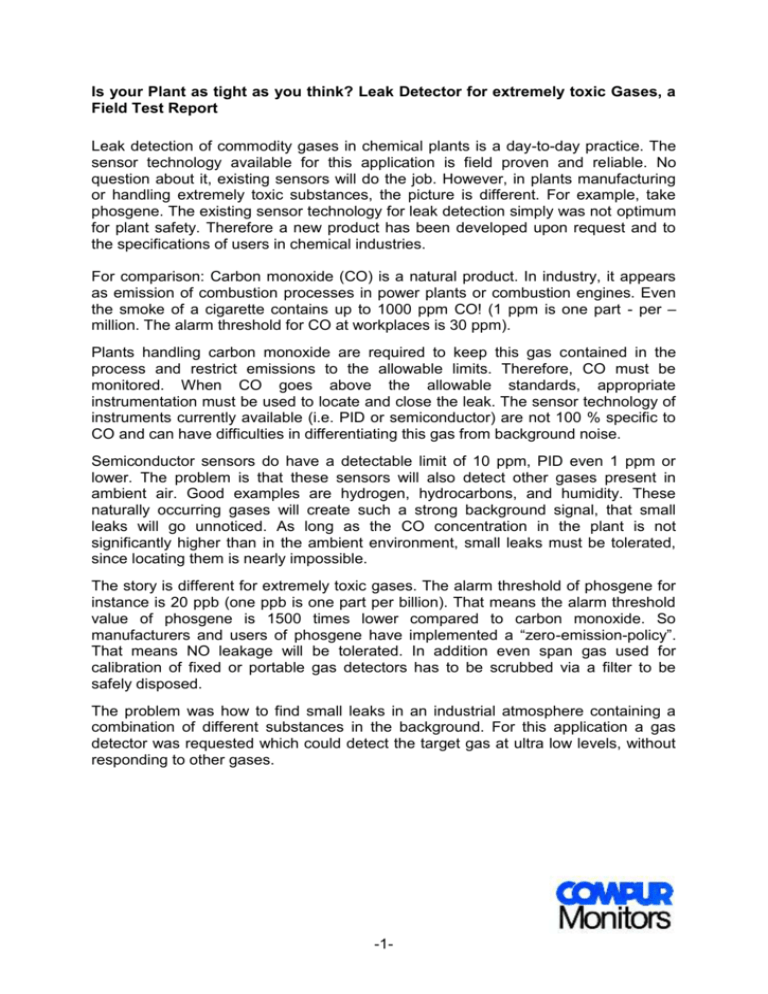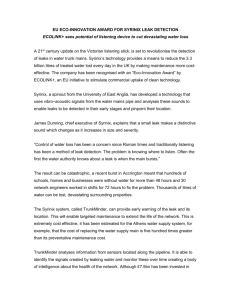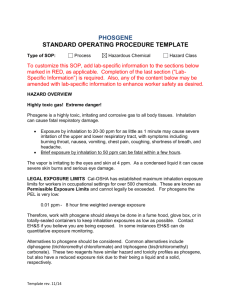Ultra - sensitive Leak Detector for extremely toxic Gases
advertisement

Is your Plant as tight as you think? Leak Detector for extremely toxic Gases, a Field Test Report Leak detection of commodity gases in chemical plants is a day-to-day practice. The sensor technology available for this application is field proven and reliable. No question about it, existing sensors will do the job. However, in plants manufacturing or handling extremely toxic substances, the picture is different. For example, take phosgene. The existing sensor technology for leak detection simply was not optimum for plant safety. Therefore a new product has been developed upon request and to the specifications of users in chemical industries. For comparison: Carbon monoxide (CO) is a natural product. In industry, it appears as emission of combustion processes in power plants or combustion engines. Even the smoke of a cigarette contains up to 1000 ppm CO! (1 ppm is one part - per – million. The alarm threshold for CO at workplaces is 30 ppm). Plants handling carbon monoxide are required to keep this gas contained in the process and restrict emissions to the allowable limits. Therefore, CO must be monitored. When CO goes above the allowable standards, appropriate instrumentation must be used to locate and close the leak. The sensor technology of instruments currently available (i.e. PID or semiconductor) are not 100 % specific to CO and can have difficulties in differentiating this gas from background noise. Semiconductor sensors do have a detectable limit of 10 ppm, PID even 1 ppm or lower. The problem is that these sensors will also detect other gases present in ambient air. Good examples are hydrogen, hydrocarbons, and humidity. These naturally occurring gases will create such a strong background signal, that small leaks will go unnoticed. As long as the CO concentration in the plant is not significantly higher than in the ambient environment, small leaks must be tolerated, since locating them is nearly impossible. The story is different for extremely toxic gases. The alarm threshold of phosgene for instance is 20 ppb (one ppb is one part per billion). That means the alarm threshold value of phosgene is 1500 times lower compared to carbon monoxide. So manufacturers and users of phosgene have implemented a “zero-emission-policy”. That means NO leakage will be tolerated. In addition even span gas used for calibration of fixed or portable gas detectors has to be scrubbed via a filter to be safely disposed. The problem was how to find small leaks in an industrial atmosphere containing a combination of different substances in the background. For this application a gas detector was requested which could detect the target gas at ultra low levels, without responding to other gases. -1- Possible methods for phosgene leak detection: a) Colorimetric paper. This method is very sensitive and specific. There are two leak location strategies: First: Wrap suspicious components such as valves or flanges up with this paper, wait for a while and then check if there is a reddish stain produced at a particular location. Second: To move the paper along a surface that shall be inspected. It is difficult to determine the dynamics of the stain with the human eye, as the stain intensity is a product of concentration multiplied with time. Either way, the consumption of paper is high, and this paper is not cheap. Pic1: Comparator for colorimetric paper stain intensity b) Electrochemical Sensors: By combining the right electrode- and electrolyte material, electrochemical sensors can be designed to be very sensitive and specific. For phosgene detection for example, the most suitable electrode material is silver. This silver grid material is embedded in high performance gel electrolyte. This electrolyte / electrode combination has unmatched sensitivity and is very specific. The detectable limit of phosgene with this technology is 2 ppb! Pic 2: The sensitive area of a phosgene sensor. Blue: Working electrode detail. Lower part: Electrolyte, Upper part: Gas phase When phosgene comes into contact with silver ions (as illustrated above) it will deteriorate to HCl and then react with the ions forming silver chloride. Silver chloride is non- soluble, which means silver ions are taken out of the equilibrium in the vicinity of the working electrode. To maintain the equilibrium, the working electrode will produce new silver ions. This way each phosgene molecule will initiate the production of two silver ions and release two electrons. Simply speaking one could say this sensor work as a phosgene-operated battery. The current produced is proportional to the number of molecules present, (the concentration). It is measured with a sensitive current amplifier. Working electrode COCl2 + H2O CO2 + 2 HCl 2 HCl + 2 Ag+ 2 AgCl + 2 H+ 2 Ago 2 Ag+ + 2 eCounter electrode ½ O2 + 2 H+ + 2 e- H2O -2- This sensor will only respond to substances producing a non-soluble salt with silver. It will not be affected by humidity, hydrogen, or hydrocarbons. To keep the sensor electrically neutral and to stimulate the electron flow, the counter electrode is kept busy producing water. A disadvantage of this method in the past has been high response time, when being compared to physical methods of detection. With diffusion, the transformation of material just takes a while. Intensive research has proven that the process of material transformation at the working electrode can be accelerated by forcing the gas to access the sensor, instead of entering by diffusion. It seems that the process of approaching the active area at the working electrode is the most time consuming step. Compur Monitors has developed a instrument with an integrated pump and a flow chamber optimized for leak detection. The result is a phosgene detector that would respond to gas almost as fast as a detector using a physical method of detection. Pic 3: The new Tracer Leak locating strategy Move the intake of the sampling probe slowly along the surface being inspected. An increasing measured value indicates you are approaching a leak. The measured value is indicated as a digital figure or a bar graph. The control tone and LED will increase their alarm frequency in ratio to the measured value, similar to a Geiger counter. The Tracer protects itself from being poisoned. If the measured value goes out of range the pump will turn off and will not start again until the concentration falls below 95% of the range. As the leak detector will eventually be exposed to very high concentrations, it must not be used as a personal monitor. To prevent the Tracer from being used as such it does not display an actual concentration. The display shows only a numerical value or bar graph proportional to the amount of gas detected. For use in dark areas the display features a backlight. The Tracer is available for the following gases: Cl2, ClO2, COCl2, HCl, HCN, H2S and NO2. The field Test The first test was took place in a Chlorine plant. The plant manager had complained about Chlorine odor in the control room, while plant engineers insisted there was no leakage. What an opportunity for us to test the new Tracer! When we entered the control room, the Tracer immediately displayed “10”. The detectable limit for chlorine is approximately 10 ppb. So the plant manager was right: -3- There was Chlorine present, although below the allowable limit which is 500 ppb. When we got closer to an analyzer cabinet, the measured value increased. We were delighted! Our delight soon came to an end. When we opened the door of the analyzer cabinet, the measured value went out of range and the pump of the Tracer switched off to protect the sensor from poisoning. We had confirmed the plant managers suspicion that there was a leakage, but were unable to locate it: The concentration was too high. Mission failed. Now we had to square the cycle: We did not want to renounce the sensitivity of the Tracer. However we had to increase the measuring range drastically to locate leaks where the background concentration had accumulated. We rejected to just change the amplifier adjustment to prevent the sensor from poisoning. We chose another approach: Since the electrochemical sensor operates like a gas operated battery, every molecule hitting the working electrode delivers or consumes one or more electrons. If we could restrict the number of gas molecules accessing this electrode being a “molecule counter”, we would be able to decrease the signal generated. We decided to use orifices restricting gas diffusion to the electrode. We needed to design the orifice in such a way that the user would be able to increase the measuring range by a factor of 20 without changing the amplifier adjustment. This was achieved through extensive testing. Now the user can in an instant replace the LOW range sensor by a HIGH range sensor and so cover a measuring range from the low ppb range up to the two digit ppm level without doing any adjustment! We returned to the chlorine plant with our new model, the HIGH range Tracer. It showed we had chosen the right measuring range. When we approached a leakage, the display would go up to 40 or 50. Moving the Tracer sample probe along tubes and fittings we could locate a number of leaks. Weak points in this installation were taps, fittings and compression glands of valves. Even Teflon or PTFE sealing washers are subject to corrosion after long term exposure to halogens. The next task was to check the bursting disc manometers. For this application the LOW range Tracer was the better choice. The smallest leaks in a fitting or tube connecting a control manometer can lead to a malfunction of the burst disc. Since the first field test, the dual range Tracer has become a well - received tool for leak detection. The Tracer is ultra sensitive where it needs to be and robust when detecting leaks in cabinets and containments. Mission completed -4-







